London 2012: 20 more Olympic oddities
- Published
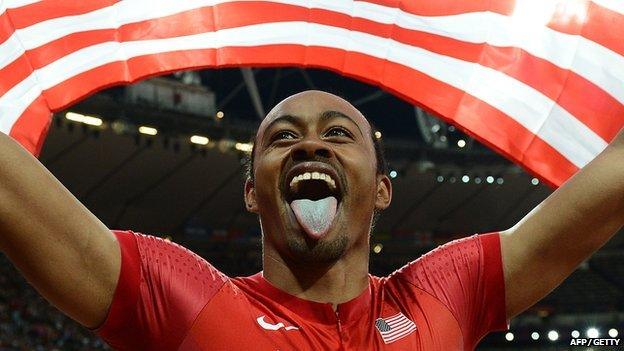
Most people are probably aware that Usain Bolt is the 100m Olympic champion, Team GB have done rather well and that Michael Phelps can swim a bit, but what about the less obvious details of the Olympics?
We gave you 20 lesser-spotted things from the Olympics on Monday and more than 400 of you emailed, Facebooked and tweeted your own oddities from the Games.
Here is a selection.
Rearranged national anthem
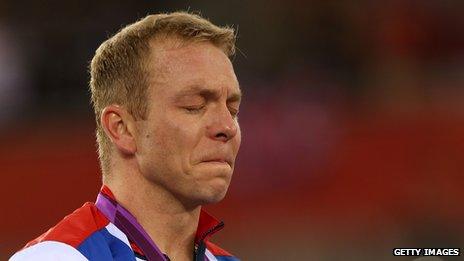
Why has the British national anthem been modified for medal ceremonies? At almost every venue, some parts of it are being played in the minor key. This is not quite how we normally hear it. Am I the only one to notice this? Peter Holland
The anthem was rearranged by composer Philip Sheppard, who recorded 205 national anthems with the London Philharmonic Orchestra, fresh for the 2012 Games. Responding to readers' queries, Sheppard says the arrangement of God Save the Queen is not in a minor key. The new version, like the original, is in the key of G major, but Sheppard says some "goosebumpy" chords have been added to create tension - this includes a passing E minor chord.
"The harmony has been subtly shifted in the bassline which means that from a musical point of view, it creates a stronger cadence returning into the home key."
Two versions have been recorded - a two-verse version and one that is only a single verse. The single verse version has been played on most occasions, according to Sheppard. "The anthems are meant to sit between a minute and a minute and [a] half - traditionally that's how long it takes to raise the flag," he says. The 3/4 (three crochets per bar) time signature remains the same as the original.
The bridge passage that leads into the "Send her victorious..." (referred to by some readers as the 'Nah-Nah, Nah-Nah' section) are not featured, because "it is not in the original tune. It is such a strong feature of another known arrangement, not a melodic feature of the original anthem," the composer says. All the changes to all the anthems were checked and approved with either the heads of state themselves or their representatives, as was God Save the Queen, over an 18-month consultation period.
Sheppard says a number of athletes were consulted over the arrangement, and it is former British triple jumper Jonathan Edwards who plays the final clash of cymbals.
"It was the loudest note in the whole of the 52 hours of recording at Abbey Road," says Sheppard.
Blue tongues
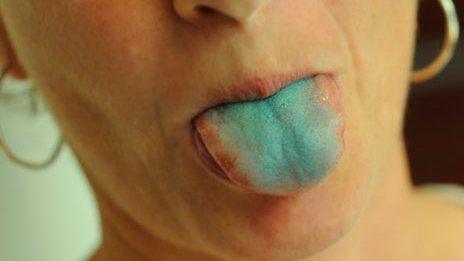
After less than a bottle of Powerade
Some of the athletes have blue tongues before they do their events. I don't know whether this is a kind of drugs test, or whether it is something else. Joe Morgan
A number of readers noticed that Team GB football goalkeeper Jack Butland and a number of other athletes appeared to have unusually blue tongues. No definitive answer can be given, but the culprit might appear to be a blue drink provided by sponsor Powerade.
Even Powerade says it isn't certain, but adds: "The berry and tropical flavour does have the potential to temporarily colour tongues in berry-like shades."
An unscientific test suggested less than a bottle was required to have the effect - see picture.
Come in athlete number 2012
Which competitor is wearing number 2012? If it is going in number/country order I think it will be either someone from Grenada or Ireland. Stan O'Reilly
A superstitious athlete may feel quite lucky if they were the one to get the number 2012 safety pinned to their lycra. But for Alfredo Arevalo, from Guatemala, it didn't bring him any luck - he didn't even get to wear it.
"Arevalo was a reserve in the men's marathon, but didn't get to run," says Keith Davies, technical director for London 2012 athletics. "The Guatemala team had the number, but it may not have even been passed on to him."
The numbers start at 1001, so that all the athletes have a four digit number. Massoud Azizi, from Afghanistan, wore 1001 for his one race in the preliminary round for the men's 100 metres.
Remote control vehicles

What about the introduction of small remote control vehicles to collect field thrown equipment? At London we have seen the little Minis running across the grass with shots, hammer and javelin on top of them. Barrie Guy
The mini Minis that have been speeding up and down the athletics field have intrigued many readers. The little cars, powered by a remote control, deliver the javelins, hammers and discuses that athletes have thrown on to the grass back to the event officials. The controls are simple - just forward, back, left and right and its cargo is loaded into the car through the sunroof. The minis take 80 minutes to charge and can run for 35 minutes without running out of power. They have a remote control range of 100m.
Bikes following the rowing
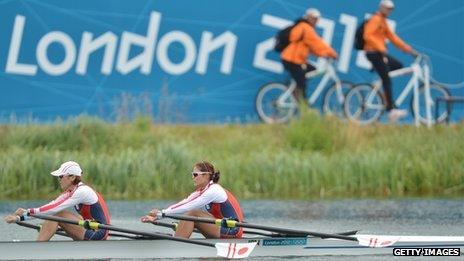
My wife and I would like to know if there is any significance to the cyclists who follow all of the rowing events on the far bank. There has been no mention of them in the commentary and we wondered if they were anything to do with the actual rowers, coaches trainers or the like? Mel Booth
The cyclists are the coaches of the crews participating who will be assessing other crews as well as their own.
No medal podium for rowers
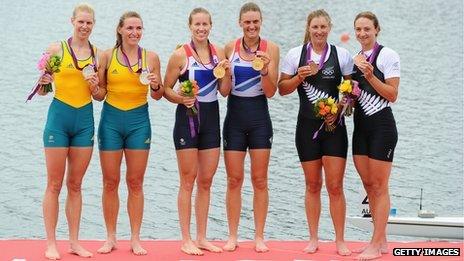
Why is there no podium when the rowers get their medals? They all stand on the level ground. Brian Greenyer
It is a longstanding core value in rowing that rowers have tremendous respect for their competitors, says Matt Smith, executive director of the international rowing federation, external, FISA. This is also played out in victory ceremonies when all medallists are on the same stage, at the same level and only the colour of the medal is the distinction between their relative performances.
"To reach the victory ceremony is the major goal. Rowing also has a tradition that the medals should be delivered immediately after the race when the spectators who witnessed the race have a chance to see the rowers up close, and the rowers are still living the excitement as well as lack of breath and sweat from the performances when they receive their medals," says Smith.
There is also the practical consideration that there can be as few as three rowers on the pontoon and as many as 27 depending on the boat class.
Shooters' shouts
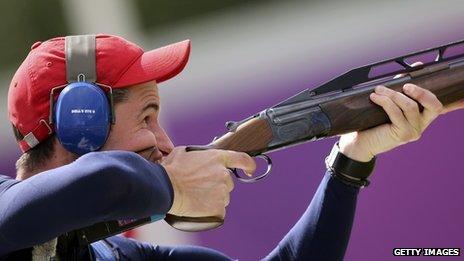
The noise that the candidates of the double-trap shooting make to activate the clay discs is bizarre. It varies between shooters; some projecting a long, sustained sound, others with a short burst. What are they supposed to be "saying"? Tom Hiom
Jonathan Young, editor of The Field, says that in the 19th Century these competitions were staged with live pigeons, a practice discontinued in the UK after campaigning by the magazine. But the terminology still lives on, he says.
The clay targets come from machines that are still called traps, after the traps originally containing the live birds. Clay shooters in the UK still call "pull!" when they want the target thrown from the machine, because in the old days the live pigeon was released from the trap by pulling a string.
"In Olympic trap shooting, the machine operates via an acoustic release (you'll see the microphone next to the shooter), so it does not matter what the shooters say, so long as it's loud and monosyllabic," says Young.
Mysterious dressage letters
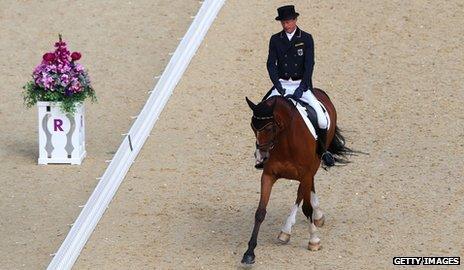
Wondering what the letters are around the dressage arena, and why they're in that order? Baz Chapman
According to the International Equestrian Federation (FEI), external, the letters just "appeared" for the first time in the 1920 Olympics held in Belgium. No-one has been able to find out the origins, although there are various theories. One is that each letter stood for the first letter of the names of cities conquered by the Romans.
A second possibility, according to the FEI, is: "It appears that in the Old Imperial German Court the walls of the Royal Mews/Stable yard were initially marked with letters indicating where each Courtier and/or riders horse was to be stood to await its rider.
K = Kaiser/King, F = Furst/Prince P = Pferdknecht/Ostler, V = Vassal, E = Edeling/Ehrengast/Guest of Honour, B = Bannertrager/Standard Bearer, S = Schzkanzler/Chancellor of Exchequer, R = Ritter/Knight, M = Meier/Steward, H = Hofsmarshall/Lord Chancellor".
However, in the 1920 Olympics, other letters were also used: A, D, L, X, I, G, and C. So far, these remain a mystery.
Reader Ian Lord points out that one of the jumps in the show jumping arena used naval flags, each representing a letter of the alphabet, to spell out LONDON 2012. No doubt this is a nod to Greenwich's maritime heritage.
Horses' hats
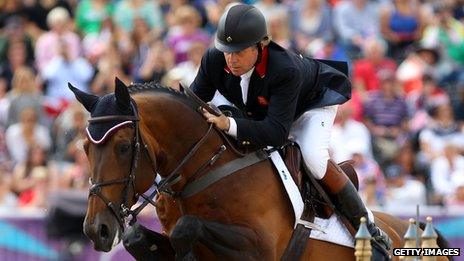
What are the little "hats" that the horses are wearing in the showjumping? John Wallis
These hats are called "fly bonnets", according to the International Equestrian Federation (FEI), external, and are used mainly for decoration purposes (some of them are very elaborate, even crystal-studded). They also help the horse with the noise in the arena as they entirely cover the ears.
Swimmers in two hats
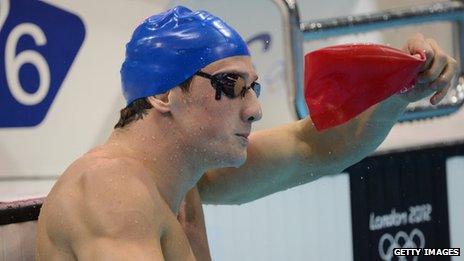
I noticed that some swimmers have been wearing two swimming hats - as if one wasn't tight enough! I think the Team GB sliver medallist Michael Jamieson wears two. Question is why? Thomas
Many swimmers do indeed wear two hats. There are a number of theories about resistance and water drag, but the simple reason is that it keeps the swimmer's goggles in place.
"It's been around for a while, but now everyone seems to be doing it," says Olympic medal winning swimmer Sharron Davies. "It is really just to make sure that your goggles don't come off, and if they do that you don't lose them completely."
But there is usually a considered order to the layering.
"There has been some talk that the silicone hats don't fit very well, and goggles don't stick to them that well," adds Davies.
"They'll wear a rubber hat first, which will keep the goggles in place, and then a silicone one over the top, perhaps because it has the country's logo on it, or because they feel that it goes a bit better through the water."
Safety pins
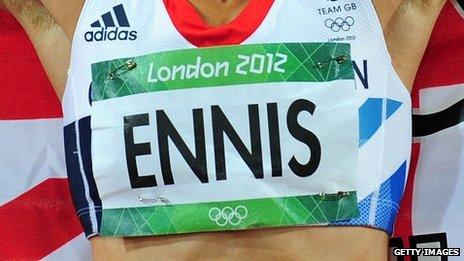
Given the huge amount of money spent on sports wear and team outfits, why has no one come up with a better solution for attaching the competitor's numbers to their vests other than using safety pins? Can't do much for the fabric and so very low tech. Marie Aitken
It's a matter of logistical convenience, says Andy Dixon, editor of Runner's World. All the bibs are produced and controlled by Locog in London, and athletes are only given their bibs in the first call-room, about 40 minutes before the start of their event, where all of their kit gets checked to make sure it complies with Olympic rules (for example, it doesn't feature any unauthorised logos). Their uniform will have been manufactured months in advance.
"Safety pins still trump self-adhesive labels, as the latter still depend upon how dry the material is when applied, and can sometimes come unstuck during rain or when the athlete gets sweaty," says Dixon.
"For all their low-tech utilitarian nature, safety pins are clearly a successful product design - they have been around since before the first modern Olympics were even a glint in Baron de Coubertin's eye. The Mycenaean Greeks, who were pretty handy metalworkers and toolmakers, are thought to have invented the safety pin, or fibula, in the 14th Century BC as a way of fastening garments together."
Running without a country
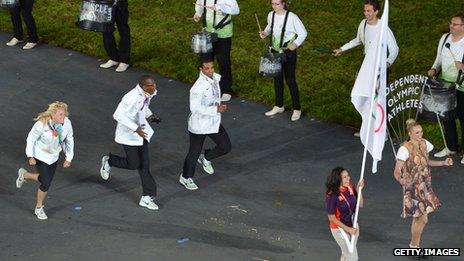
I saw one athlete running whose country was code was IOA and his flag was the Olympic rings instead of a recognisable country flag. Apparently this means he's an "Independent Olympic Athlete" - what's all that about? Marcus Davidson
Athletes who don't have a National Olympic Committee can take part in the Olympic Games as "Independent Olympic Athletes" (IOA), according to the International Olympic Committee. They compete under the Olympic flag.
In London, there are four IOA, externals.
Guor Marial was born in what is now South Sudan, which does not currently have a recognised NOC. The athlete, who does not hold a passport from any country, is a permanent resident with refugee status in the US but not a citizen. As such he is unable to compete for the US, South Sudan or Sudan.
South Sudan has not yet fulfilled certain "technical" conditions such as the setting up of solid sporting structures (national federations, sport clubs) which are a prerequisite for the creation and recognition of an NOC.
The other competitors are from the former Netherlands Antilles. In 2010, the Dutch Caribbean dependency ceased to exist and the five islands were given a new institutional and constitutional structure within the Kingdom of the Netherlands. The IOC withdrew recognition from the NOC of the Netherlands Antilles and approved a number of accompanying measures aimed at preserving the interests of the athletes.
Equal podiums
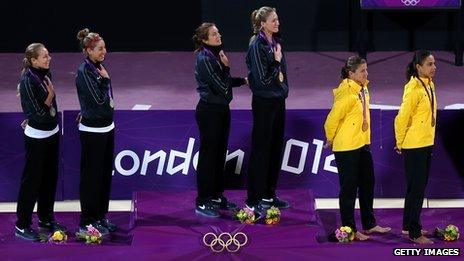
Why is the medal podium the same height for the silver and bronze medallists? I'm sure I grew up with the silver podium being higher than bronze? Kirit Barot
The instructions for the use and heights of podiums and platforms were introduced by the IOC. They were first used in the 1932 Olympic Games, where the IOC stipulated that medallists would stand on "pedestals". It said only that the centre would be higher than the other two sides.
No distinction was made regarding the height of the second and the third-place platform.
In most of the Games, the second and third-place platform have been the same height. But in the case of certain Games - Moscow 1980, Sarajevo 1984, and Lillehammer 1994 - the three platforms were at different levels. No explanation is provided in the respective official reports as to why this was the case.
Empty lanes

Why are we not using the inside (lane 1) for the 200m and 400m races? Seems odd to me when the longer races all use the inside lane. Chris Childs
Middle and long distance athletes (800m upwards) use the inside lane because it is the shortest distance (400m) around the track during races where you're not required to stay in lane for the whole race, says Andy Dixon, editor of Runner's World.
"The start and finish point of lane one is the same (the finish line), whereas outer lanes' starting points are staggered further forward to even out the fact that their laps are longer.
"Depending on the width of the lane, running a complete lap in lane two would add at least five metres to the 400m distance, lane three 10 or more metres, and so on. This is why 5000m or 10,000m athletes would rather fight for position with each other close to the inside kerb rather than run where there is more space in lanes two or three.
"Lane one isn't used in sprint races (up to 400m) because the tightness of the bend is thought to make it more difficult to tackle at higher speeds."
Blue hockey pitch
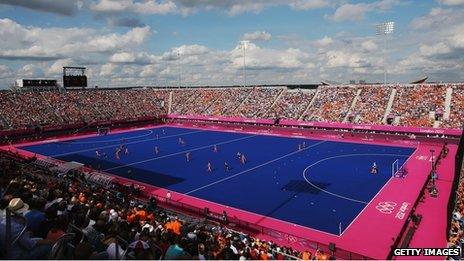
Hockey: What's that weird-looking blue pitch made of? Richard Saunders
When watching the hockey the pitch appears to be wet. It looks like spray when the ball is hit hard. Is water used on the pitch? Colin Turner
London 2012 is the first world hockey event to be played on a different coloured synthetic turf to the traditional green. The water-based surface at the Hockey Centre at the Olympic Park in London uses a high-performance polyethylene resin, helping to make it the world's fastest pitch. The run-off areas are shocking pink, and the colour changes are designed to improve viewing for players, officials, spectators and broadcasters.
Dresses and sashes
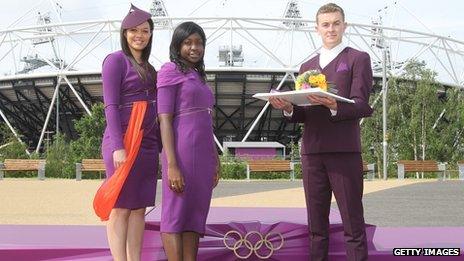
At various events there are hostesses wearing purple dresses with a huge sash, of a different colour, hung from the waist - presumably the sash colour relates to the sport associated with them. However, one lady at an event (sorry, forgotten which one!) wore the purple dress, but no sash at all. Any explanations please? Jan Huntingdon
Costumes for the victory ceremonies, worn by some 100 female volunteer athlete and presenter escorts and 200 male flower and medal bearers, have been designed by the postgraduate students of the Royal College of Art. According to Locog, athletes' escorts wear a sash, but presenter escorts do not. The sashes relate to the look of the venue.
The set of uniforms were inspired by Greek mythology and British heritage, external, according to Locog.
Black boxes
What are the small black boxes in front of some of the crowd in the stadium please? Tommy Matthews
The "boxes" referred to could be the "audience pixels". The pixel screen extends around the audience seating area and is made up of 70,799 small panels mounted between the seats, according to Locog. Each of these panels has nine LED pixels - there are nearly 640,000 in total - which are controlled by a central computer. At certain points, the audience will be asked to hold up the panels and images and effects flood the Stadium via 317km of cable that connects to the central control.
Around the officials' area the Olympic Broadcast Service has some equipment, which is sometimes covered with tarpaulin to protect it from heat. This could look like a box on screen.
Names on medals
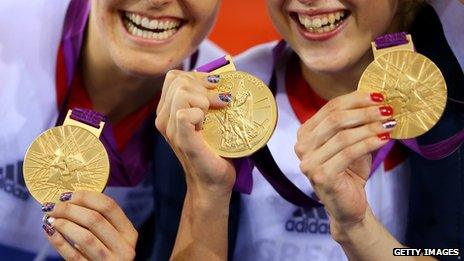
Are the medals engraved with the winner's names and sporting event or are they all the same? Peter Brown
The medals are engraved with details of the sport but not with the athlete's name. Space has been left, however, if the athletes wish to engrave their names themselves. Approximately 4,700 medals will be required for the 805 victory ceremonies
Hong Kong or China?
There was a cycling competitor representing Hong Kong? How can that be? Is HK not now China? Can you explain? David Booth
Hong Kong is governed under the principle of "one country, two systems", under which China has agreed to give the region a high degree of autonomy and to preserve its economic and social systems for 50 years from the date of the handover. There are 204 National Olympic Committees representing both sovereign nations and other geographical areas. They include the Sports Federation and Olympic Committee of Hong Kong, China, the Chinese Taipei Olympic Committee and the Chinese Olympic Committee. Note that there are more NOCs than recognised countries.
Is that a fly?
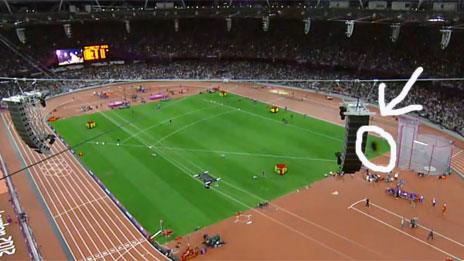
It's not a shadowy figure on the grass. It's a fly in front of the camera
For the last two evenings, 4th and 5th Aug, (and perhaps longer), all through the evening schedule, every time there is a view of the stadium from above and just for a second before the result of the latest event is flashed up on the screen there is a dead fly wobbling back and forth attached to a black box. Surely it is not a dead fly! Chris Gitins
In athletics, as the camera was showing a shot from the roof, most of the time just before the result of the race on TV, looking at the direction of the loud speaker in the middle. There is a spider waving around presumably because the web was waving in the wind. Larry Chau
Many people have written in about this. So far, there is no explanation.